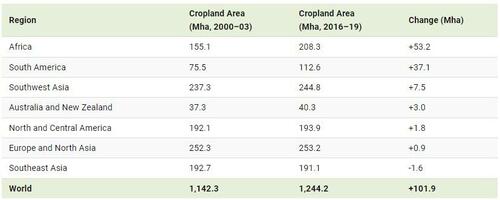Over the last 50 years, the world’s human population worldwide has grown exponentially.
And, as Visual Capitalist’s Adam Symington details below, this population explosion brought greater food production needs with it, through livestock breeding, cropland expansion, and other increases in land use.
But how evenly is this land distributed globally? In this graphic, Adam Symington maps global croplands as of 2019, based on a 2021 scientific paper published in Nature by Peter Potapov et al.
The World’s Croplands
Croplands are defined as land areas used to cultivate herbaceous crops for human consumption, forage, and biofuel. At the start of the 21st century, the world’s croplands spread across 1,142 million hectares (Mha) of land.
Some of these croplands have since been abandoned, lost in natural disasters, or repurposed for housing, irrigation, and other infrastructural needs.
Despite this, the creation of new croplands increased overall cropland cover by around 9% and the net primary (crop) production by 25%.
Africa and South America Lead Croplands Expansion
In 2019, croplands occupied 1,244 Mha of land worldwide, with the largest regions being Europe and North Asia and Southwest Asia at around 20% of total cover each.
Interestingly, even though Africa (17%) and South America (9%) held lower percentages of the world’s croplands, they saw the highest expansion in croplands since 2000:
South American nations including Argentina, Brazil, and Uruguay witnessed a steep rise in crop production between 2000 and 2007. Agricultural growth in the region can be attributed to both modern agricultural technology adoption and the production of globally demanded crops like soybeans.
A similar expansion in croplands within Sub-Saharan African countries at the start of the 21st century continues to persist today, as producers ramp up crop production for both exports and to try and alleviate food scarcity.
Much of these the world’s croplands were once forests, drylands, plains, and lowlands. And this loss in green cover is clearly seen across Africa, South America, and parts of Asia.
However, some regions have also witnessed tree plantations, orchards, and aquaculture replacing former croplands. One such example is Vietnam’s Mekong Delta, and indeed Southeast Asia was the only region that saw an overall decline in cropland cover from 2000 to 2019.
Moving Towards Sustainable Agriculture
The expansion of croplands has also come at a cost, destroying large stretches of forest cover, and further contributing to wildlife fragmentation and greenhouse gas emissions.
However, hope for more sustainable development is not lost. Nations are finding ways to improve agricultural productivity in ways that free up land.
As global demand for food continues to increase, agricultural expansion and intensification seem imminent. But innovation, and a changing climate, may elevate alternative solutions in the future.
Loading…
This post was originally published on this site
The post How Much Of The World Is Covered By Croplands? appeared first on Nemos News Network.
 RSS Feed
RSS Feed













 January 11th, 2024
January 11th, 2024  Awake Goy
Awake Goy 


 Posted in
Posted in  Tags:
Tags: 

















Most of the world’s land mass is empty! Earth and man are a symbiotic system, one needs the other, and inferring humanity is a scourge on the earth, or something separate to it, is wrong. We don’t need any more false excuses for genocide. We have many plant food sources and growing them in a healthy way would sustain us – get rid of GMO, health damaging chemical fertilisers, seedless grapes and their ilk (they’re infertile). Have a healthy water system (check out Viktor Schauberger – the Water Wizard) and stop polluting with fluorides and phosphates, etc. WE are not the problem, shortage of land is NOT the problem; corporate greed IS.